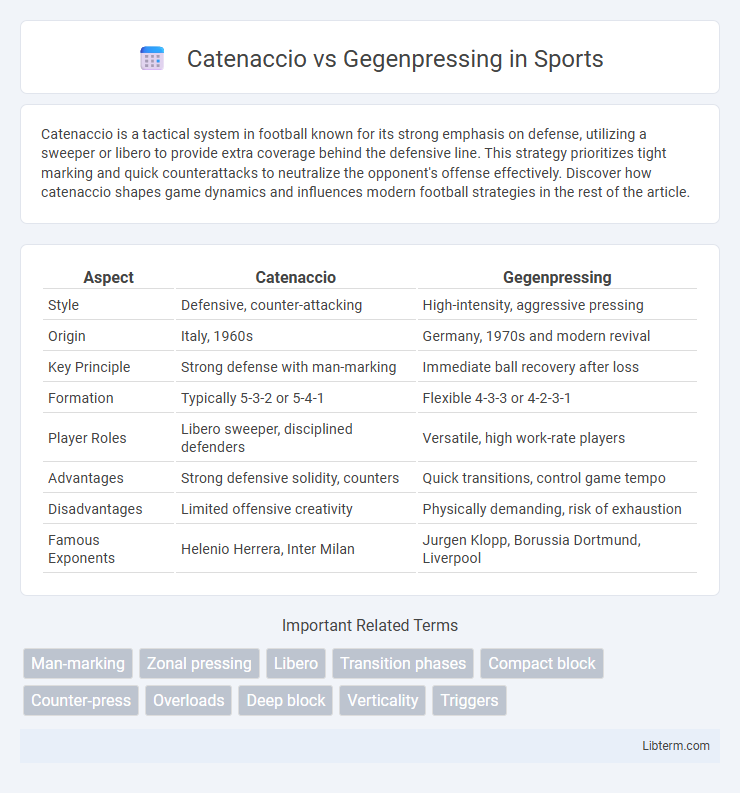Catenaccio is a tactical system in football known for its strong emphasis on defense, utilizing a sweeper or libero to provide extra coverage behind the defensive line. This strategy prioritizes tight marking and quick counterattacks to neutralize the opponent's offense effectively. Discover how catenaccio shapes game dynamics and influences modern football strategies in the rest of the article.
Table of Comparison
| Aspect | Catenaccio | Gegenpressing |
|---|---|---|
| Style | Defensive, counter-attacking | High-intensity, aggressive pressing |
| Origin | Italy, 1960s | Germany, 1970s and modern revival |
| Key Principle | Strong defense with man-marking | Immediate ball recovery after loss |
| Formation | Typically 5-3-2 or 5-4-1 | Flexible 4-3-3 or 4-2-3-1 |
| Player Roles | Libero sweeper, disciplined defenders | Versatile, high work-rate players |
| Advantages | Strong defensive solidity, counters | Quick transitions, control game tempo |
| Disadvantages | Limited offensive creativity | Physically demanding, risk of exhaustion |
| Famous Exponents | Helenio Herrera, Inter Milan | Jurgen Klopp, Borussia Dortmund, Liverpool |
Introduction to Catenaccio and Gegenpressing
Catenaccio is a highly organized defensive football strategy originating from Italy, designed to neutralize attacking threats by emphasizing a strong backline and man-marking system. Gegenpressing, popularized by German football, involves an aggressive, high-intensity approach where teams immediately press opponents after losing possession to regain control quickly. Both tactics prioritize control but contrast sharply in defensive rigidity versus proactive pressure.
Historical Origins of Both Tactics
Catenaccio, emerging in the 1940s Italian football, was popularized by Nereo Rocco and Helenio Herrera, emphasizing a highly structured defensive system with a sweeper behind the line to neutralize opposing attacks. Gegenpressing, developed in the late 20th century by German coaches such as Jurgen Klopp and Ralf Rangnick, focuses on immediate high-intensity pressure after losing possession to quickly regain control and disrupt the opponent's build-up play. Both tactics reflect distinct footballing philosophies rooted in their national contexts: Italian pragmatism versus German high-energy aggression.
Key Principles of Catenaccio
Catenaccio, an Italian defensive football strategy, prioritizes a highly organized, tight defense with a traditional sweeper (libero) positioned behind the line of defenders to intercept opposition attacks. The key principles include man-marking, tactical discipline, and rapid counter-attacks exploiting opponents' weaknesses. This system emphasizes minimizing defensive risks while capitalizing on precise, opportunistic offensive transitions.
Fundamental Concepts of Gegenpressing
Gegenpressing, a tactical approach popularized by German football, focuses on immediate intense pressure after losing possession to quickly regain control and disrupt the opponent's build-up. This strategy relies on coordinated team pressing, rapid transitions, and collective defensive effort to force turnovers high up the pitch. Unlike the defensive Catenaccio system, Gegenpressing emphasizes aggressive ball recovery and fluid attacking play to maintain dominance.
Notable Teams and Coaches Utilizing Catenaccio
Notable teams employing Catenaccio include Inter Milan during the 1960s, famously managed by Helenio Herrera, who perfected the defensive system emphasizing tight marking and swift counter-attacks. Other prominent coaches linked to Catenaccio are Nereo Rocco with AC Milan, implementing the tactic to secure multiple Serie A titles, and Giovanni Trapattoni, who adapted the strategy for Juventus in the 1970s and 1980s. These teams and coaches established Catenaccio as a hallmark of Italian football's tactical discipline and defensive prowess.
Renowned Clubs and Managers Mastering Gegenpressing
Renowned clubs like Liverpool and RB Leipzig have mastered Gegenpressing under managers Jurgen Klopp and Julian Nagelsmann, emphasizing rapid ball recovery and high pressing intensity. Klopp's tactical innovations at Borussia Dortmund and Liverpool transformed Gegenpressing into a dominant style of play in modern football. This proactive approach contrasts with the defensive Catenaccio system, highlighting the strategic evolution led by these top-tier clubs and managers.
Tactical Strengths and Weaknesses: Catenaccio
Catenaccio's tactical strength lies in its highly organized defensive structure, employing a sweeper (libero) to provide additional cover behind the backline, effectively neutralizing attacking threats and minimizing goal opportunities. Its weakness includes limited offensive flexibility and reliance on counterattacks, which can render the team vulnerable if possession is lost or if opponents successfully bypass the defensive blocks. This strategy demands disciplined defenders and can struggle against dynamic, high-pressing teams that disrupt buildup play early.
Tactical Pros and Cons: Gegenpressing
Gegenpressing excels in quickly regaining possession by applying immediate high pressure, disrupting opponents' build-up play and creating rapid attacking opportunities. Its tactical strength lies in forceful collective pressing and swift transitions, which require high fitness and coordination to maintain effectiveness throughout the match. However, gegenpressing leaves teams vulnerable to quick counterattacks if the initial press is bypassed and can lead to defensive instability due to the aggressive positioning of players.
Head-to-Head: When Catenaccio Meets Gegenpressing
Catenaccio, a defensive tactical system popularized by Italian football, relies on tight man-marking and a sweeper to stifle opposition attacks, while Gegenpressing, favored by German and modern European teams, emphasizes immediate high pressing after losing possession to regain control quickly. In head-to-head encounters, Catenaccio often tests Gegenpressing's high-energy approach by exploiting spaces left during aggressive pressing, requiring disciplined organization to counter rapid transitions. The effectiveness of each style significantly depends on player adaptability, with teams blending structured defense and dynamic pressing to disrupt the opponent's rhythm and exploit tactical weaknesses.
Future Trends in Football Tactics
Catenaccio's defensive rigidity is gradually giving way to the dynamic intensity of gegenpressing, emphasizing rapid ball recovery and high pressing. Future football tactics are likely to integrate hybrid models that combine structured defense with aggressive counter-pressing to maximize control and transition speed. Advanced analytics and player tracking technologies will drive these tactical evolutions by optimizing positioning and reaction times on the pitch.
Catenaccio Infographic

 libterm.com
libterm.com